2014 Dodge Viper Srt Top Speed
My boyhood shelves were packed with all sorts of toys, but my favorites were miniature diecast cars. Even though I'd spend hours building challenging gravity tracks for the smallest and sleekest of the bunch, my prized vehicles were not scaled-down production models. Instead, I preferred to daydream about the fascinating showcars and fictitious models with their radical styling, giant wheels and oversized engines. They were the standouts that didn't need to roll down a plastic road, as they could shoot across the carpet, launch over a book and drive up the walls with impunity.
Understandably, then, I was recently compelled to shake off a flood of youthful memories when a 2014 SRT Viper GTS was dropped off in my driveway, complete with bright-red paint, black racing stripes, massive tires and the biggest engine in the land. It was exaggerated and outrageous – nothing short of a life-size version of my favorite childhood Matchbox car.
Only this time, I was handed a real key.
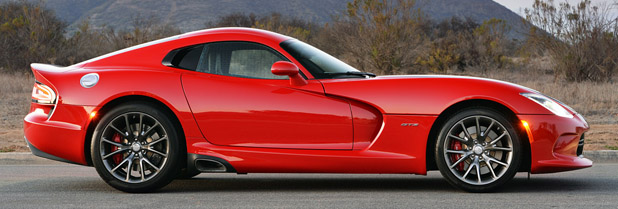

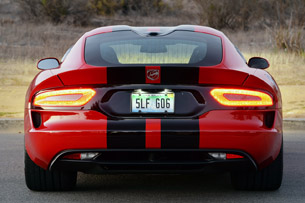
The 90-degree engine is now rated at 640 horsepower at 6,200 rpm and 600 pound-feet of torque at 5,000 rpm.
After skipping a few model years, the fifth-generation Viper returned at the 2012 New York Auto Show. It debuted not wearing its traditional Dodge badges, instead arriving as part of Chrysler Group's new performance-oriented SRT (Street and Racing Technology) brand. Previously, the latter was an in-house performance skunkworks for Chrysler products, but the Viper marked SRT's debut as a standalone marque. And while the new car wasn't a complete clean-sheet design, it had received major upgrades and lots of lightweight materials, including a cast-magnesium firewall, an aluminum cross-brace under the hood, aluminum doors, and plenty of carbon fiber, including its clamshell hood, roof and decklid. The lighter materials not only made the revised vehicle stronger, it cut nearly 100 pounds off its weight.
Returning under the hood, of course, is the Viper's signature V10. The all-aluminum, naturally aspirated 8.4-liter engine still features only two valves-per-cylinder and sequential fuel injection – old school – but it uses race-bred forged aluminum pistons, a forged steel crankshaft and a lightweight composite intake. To preserve its on-track performance, engineers fitted it with a swinging pickup in the oil sump to ensure lubrication under racing conditions. Feasting on premium unleaded, the 90-degree engine is now rated at 640 horsepower at 6,200 rpm and 600 pound-feet of torque at 5,000 rpm. An improved Tremec TR6060 six-speed manual gearbox and a GKN ViscoLok speed-sensing limited-slip rear differential sends the power the rear wheels.




Premium GTS models come fitted with two-mode Bilstein DampTronic shock absorbers.
The balance of the Viper's mechanical specifications includes a suspension setup with cast-aluminum, unequal-length upper and lower control A-arms fitted front and rear, with fixed damping on the standard model. Premium GTS models, however, come fitted with two-mode Bilstein DampTronic shock absorbers as standard equipment. The rack-and-pinion steering continues to use traditional hydraulic assist for maximum feel. Standard brakes include oversized 14-inch ventilated iron brake rotors with four-piston monobloc calipers, but an optional SRT Track Package offers upgraded brakes with lighter StopTech two-piece slotted rotors (iron friction surfaces with aluminum hats). The anti-lock braking system has also been upgraded to utilize four channels, instead of the previous car's three channels.
As before, the Viper returns with big shoes. The standard wheel/tire package fits five-spoke Rattler 18-inch alloys up front (wearing 295/30ZR18 summer-compound Pirelli P Zero tires) and 19-inch alloys (355/30ZR19 tires) in the rear. Ultra-lightweight multi-spoke Venom-Hyper wheels with sticky race-ready Pirelli P Zero or Corsa tires are on the options list.



My previous experience with this new Viper was at Sonoma Raceway, where I had the opportunity to drive several versions on public roads, a temporary autocross/skidpad in a large parking lot, and on the main track at the Northern California circuit. But there were no closed venues with fleets of Vipers this time – just a week with this one car on the spectacular roads around the greater Los Angeles Basin.
Including $1,995 for destination, the total MSRP was $140,930.
The base price of a premium GTS model sits at $124,985. Bumping up the sticker on my press car was the $7,500 GTS Laguna Interior package (Sabelt premium seats, Alcantara headliner, SRT steering wheel, SRT premium audio and more), $5,000 for painted black racing stripes, $350 for red seatbelts, $1,100 for the forged wheels and a $2,600 gas-guzzler tax. Including $1,995 for destination, the total MSRP was $140,930.
Once seated inside this fifth-generation Viper, most are surprised by how accommodating its cabin is. My six-foot, two-inch frame fit tightly, yet I wasn't cramped, with decent head-, shoulder- and legroom. But as I had during my First Drive, I took issue with the slanted footwell, as the power-adjustable three-pedal cluster has been moved leftward to accommodate the oversized transmission tunnel. The result is that there is very little room between the clutch and the left wall of the pedal box, meaning only my narrowest size-11 racing shoe would fit in the space. There is a wrench-adjustable dead pedal down in the footwell, which I am sure owners will tweak to their liking, but it's small and isn't optimally located.
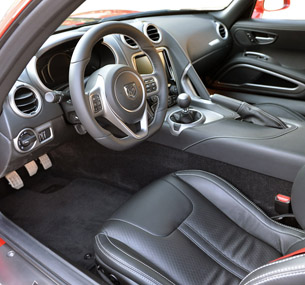
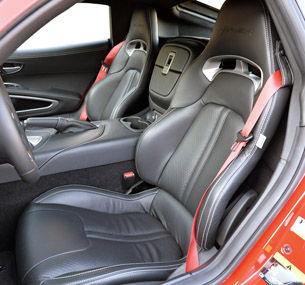
With key fob in pocket, the V10 fired up after the red start/stop button was held for about a second. The awakening process was both physical and audible, as all 8.4 liters shook the chassis as the engine cleared its throat out each side of the body (there is no crossover pipe). As with previous generations, idling remained an impatient rumble, with an odd, burbling soundtrack that sounded more like a trolling fishing boat in harbor than a polished high-performance sports car.
I found the Viper's manual gearbox refreshingly mechanical in operation.
I found the Viper's manual gearbox refreshingly mechanical in operation, with its pleasingly short throws both accurate and tactile. The clutch was heavy, but not overburdening, with a nice take-up and engagement. Although SRT has fitted the Viper with a fuel-saving skip-shift 'feature' that forces drivers to jump from first to fourth gear under light acceleration, a firm right foot on the pedal or an extended climb around the tachometer will override it every time.
When fitted with active damping, this SRT offers its operator a number of suspension and stability control choices. There are two damper settings (Street and Track) and five stability control configurations (On, Sport, Rain, Track and Off). Rain mode, which is new for 2014, increases the sensitivity of the ESC by lowering its yaw and slip targets. Don't assume this softened setting takes the bite out of the beast - Rain mode is still much more aggressive than the default setting in a Chevrolet Corvette Stingray, for instance, and the car can still get out of hand ("It's a Viper. It should scare some people," boasted Erich Heuschele, from SRT Engineering, during a phone interview). The SRT starts with Street damping and with ESC on, which allows plenty of wheelspin.
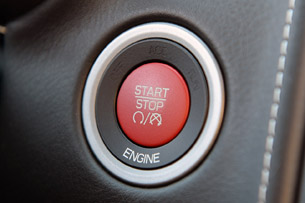



Massive high-performance summer tires readily provide gumball grip – provided they have heat in them. Unfortunately, morning startup in February (even in Southern California) is not that time. Leaving the driveway, and during my first dozen or so launches, required a delicate touch on the throttle. With even the slightest indelicacy, the V10 broke its chilled steamroller rears free every time – even when only moderate pressure was applied to the aluminum gas pedal. I soon learned to monitor the car's real-time tire pressure monitoring system ( TPMS) for the go ahead. When the numbers had risen by a few pounds at each corner from their cold pressures, I concluded that I had grip.
The tone is interesting, albeit not particularly pleasant, but even so, nobody holds their ears.
At that point, with four tires, four gallons of coolant and nearly three gallons of synthetic oil all at proper operating temperature, it took all the willpower in the world to prevent me from slamming my right foot to the floor and endlessly peeling out, leaving nothing but an expensive trail of Pirelli particulates in my wake. With 600 pound-feet of torque on tap, it would have been very easy to restripe all of the roads in town.
It's very difficult to describe the Viper's sound. Five cylinders exhaust out of each side, not the rear, which puts the vehicle's occupants in the stereoscopic center of the action. With 2,500 rpm on the tachometer, the powerplant's noise is loud and boisterous – nothing like the silky sound of an inline-six, the smooth deep growl of a well-tuned V8 or the lovely purr of a V12. The tone is interesting, albeit not particularly pleasant, but even so, nobody holds their ears.
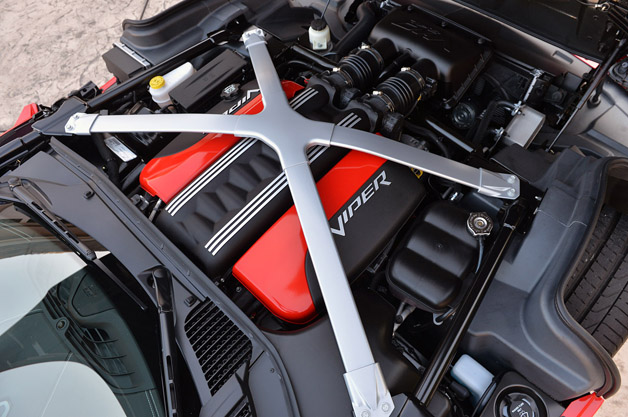
At least until redline. When the V10 pushes over 5,000 rpm, a clamorous and seemingly unrestrained dissonant sound roars from each side pipe and assaults the cabin. Unprepared occupants are caught off guard by the nearly deafening noise (several of my passengers visibly cowered and covered their ears), while their senses were simultaneously abused by the Viper's crushing g-forces. A bruising sprint from standstill to 60 miles per hour happens too quickly to be appreciated. But a 0-100 mph shot, which takes just over seven seconds, becomes life-altering. "Brutal" is the best way to describe the V10's demeanor.
"Brutal" is the best way to describe the V10's demeanor.
The Viper's driving position, aft of that long powerplant, puts the operator just ahead of the rear wheels but behind the chassis' rotational axis. While the Ferrari F12 and Mercedes-Benz SLS share similar layouts, the SRT's comically large 8.4-liter engine makes it the true Gee Bee R-1 of the automotive world. Kicking the tail out, which takes nothing more than an extra inch of throttle travel, means the occupants swing in an arc that emphasizes the pendulum effect to an unnerving level. Even skilled drivers need to readjust their internal gyroscopes to accommodate this vehicle's unique mannerisms.
With everything warmed to working order, running at a spirited pace through the canyons required full concentration, as the Viper's wide stance and long hood made positioning its shoulders within the narrow painted stripes a challenge. Visually, the vehicle appears imposing and heavy, but a GTS coupe with forged wheels tips the scales at just 3,399 pounds – more than 100 pounds lighter than a BMW 335i sedan – with a balanced 50/50 weight distribution. In practice, the heavily weighted steering was accurate and the chassis surprisingly responsive, both of which helped the Viper feel surprisingly light and agile on its feet.
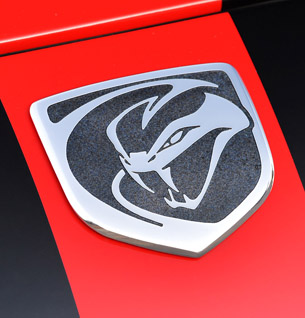
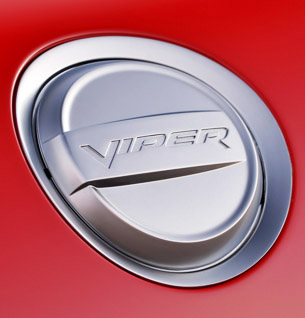
It's not possible, or even remotely legal, to wring out the last drop of performance on public roads, but the Viper is incredibly entertaining, even at eight-tenths. At that level, where the rear wheels are still following the tracks of the fronts around a corner, SRT's finest holds tenaciously in corners, accelerates ferociously on short straights and brakes mercilessly hard. The enthusiast in you will be completely absorbed by the experience – it's one best enjoyed with the windows all the way down and the 900-watt audio system silenced.
Aside for a complete lack of grip when it's cold and rainy, outward visibility is this car's greatest challenge.
The Viper is addictive as a weekend toy for a talented enthusiast, but it's understandably less charming when forced to drive at two-tenths. Under such Monday-through-Friday conditions, when asked to sit for three hours in stop-and-go traffic or drive 100 miles in a blinding rainstorm – I was forced to do both – some of its shortcomings rise to the surface.
Aside for a complete lack of grip when it's cold and rainy, outward visibility (especially over one's right shoulder) is this car's greatest challenge. I also found tight parking maneuvers, even with the backup camera, to be a trying exercise. And while I became accustomed to the acrobatics required to jump into the cabin, my passengers frequently leaned on the hot aluminum door sills (why can't they be made of less heat-conductive carbon fiber?). Lastly, the climate control and suspension buttons are poorly placed (the temperature buttons should be on one side and the damper settings on the other). On a positive note, the exhaust routing to the sides means the Viper's trunk won't melt your Girl Scout cookies, a common occurrence on many high-performance sports cars.

After my brief introduction in late 2012, I said the new SRT was, "the best two-door coupe to ever wear Chrysler's coveted Viper badge... the finest [sports car] this country has to offer." Unfortunately for Pentastar lovers, that assessment was made before I drove the all-new 2014 Chevrolet Corvette Stingray, a model pegged as its closest domestic competition. Rather than skirt the issue, I will be quite frank: purely in terms of objective sports car dynamics, the new Stingray – and presumably its upcoming Z06 model – have the Viper beat.
Its engineers have left its challenging nature and rawness mercifully intact.
Yet that shouldn't ruffle the feathers of SRT loyalists, as the Viper delivers much more than the Corvette in terms of driving captivation and emotional gratification – the two most tangible reasons why owners enjoy their sports cars. This V10-powered coupe is more refined than its predecessor, but its engineers have left its challenging nature and rawness mercifully intact. It rewards talent, and it rightfully scares the hell out of novices. Uncommon on the road compared to the Chevy, this strident SRT also enjoys a curious stage presence and rolls with double the cachet.
The 2014 Viper GTS may not be this nation's finest sports car, but it is its most engaging drive. And in this car guy's eyes, that catapults it to the top of the charts.
2014 Dodge Viper Srt Top Speed
Source: https://www.autoblog.com/2014/03/17/2014-srt-viper-gts-review/
